Items tagged with 'apples'
Apples, branded and trademarked
The Vox video embedded above tracks the rise of the branded apples that have been popping up in supermarkets over the last decade or so -- you know, SweeTango, Zestar, Kanzi, even Pink Lady (which is a branded version of an old apple called Cripps Pink).
Two of these sorts of new-school apples were developed by Cornell: the SnapDragon and Ruby Frost.
These new branded varieties are also known as "club" apples and they're production and marketing is usually licensed by a single entity, which an NPR story looked a few years ago, raises some issues for apple growers.
One of the important threads of this story that the Vox video doesn't really touch on is that the universe of apple varieties is huge -- there have been literally thousands of varieties of apples. It's just that many varieties fell out of favor because they didn't fit into the modern supermarket system because of the way they look, or they way they keep, or some other issue with standardization. (The inverse of that: the dreaded Red Delicious, which fits a lot of the modern requirements but generally tastes bad.)
We're lucky to have a bunch of apple orchards in this region. And many of those orchards grow a large variety of apples, both old-school varieties and some of the newer varieties. Examples: Bowman in Rexford grows almost 50 different varieties and Samascott in Kinderhook grows something like 80 varieties (we've seen the spreadsheet).
So it's worth stopping by these orchards and asking for something different or unusual. Not all of the old or unusual apples are great, but some of them are interesting and you might find a new favorite.
Step away from the Honeycrisp
This is our annual reminder that Honeycrisp are overrated. Get yourself an apple like one of those SnapDragons from Cornell -- still has the crunchy texture, but it actually tastes like something more than water.
Earlier
+ Beyond boring apples
+ Growing a wider variety of flavors for cider
+ Lost and found apples
An orchard for Washington Park
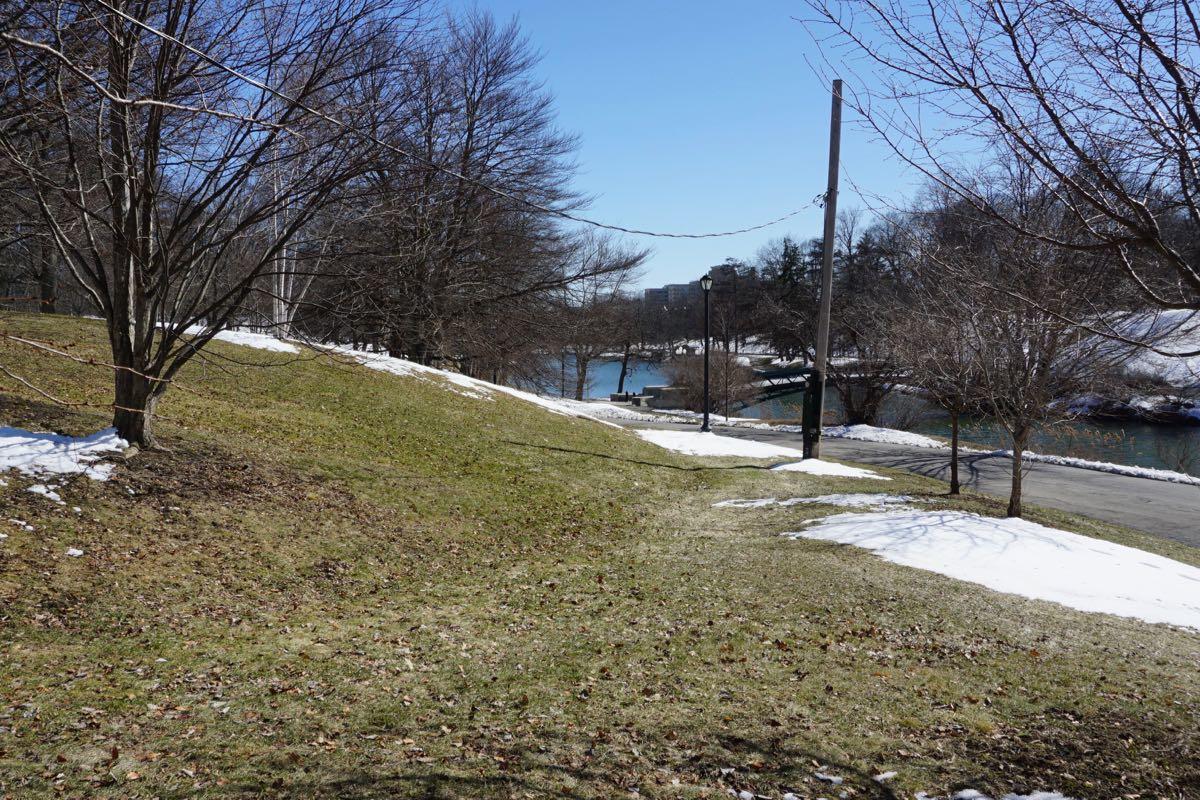
Soon to join the many trees of Albany's Washington Park: eight varieties of apple tree.
Nine Pin Cider and Samascott Orchards in Kinderhook will be planting a small apple orchard on a sunny slope above the lake near the spot where Thurlow Terrace meets the park.
"We have all these statues honoring things around the capital that are important to New York State," said Nine Pin founder Alejandro del Peral this week. "The idea is to put some sort of testament to New York's apple agricultural resource, which is world class."
Possibly unpopular opinions about apple picking

Upstate New York is one of the world's premier spots for growing apples. And one of the great things about living in this specific part of it is that we're close to many different orchards.
So, let's just be clear about this: Yes, go apple picking. Go apple picking however you want. Have fun in the way you want to have fun. This isn't my lawn. You don't have to get off it.
But as someone who's become a bit of an apple nerd -- and can think of few places better places to be than an orchard on a warm autumn weekend -- I've developed some curmudgeonly opinions about apple picking.
And you're probably going to disagree with a few of them.
Growing a wider variety of flavors for cider
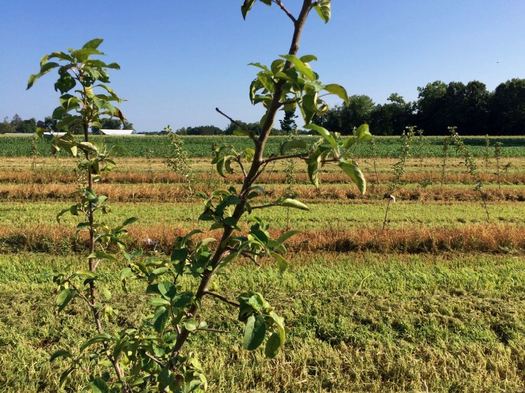
These trees will grow apples with a different accent.
On a small plot off to the side of an orchard in Kinderhook, there are rows of apple trees with names that are probably unfamiliar to even the most ardent apple lovers in America: Yarlington Mill, Kingston Black, Dabinett, Tremlett's Bitter.
That's understandable: These apples are not from around here. They're varieties that originated in England. And they have the sort of dry, astringent accent that registers right away. So bracing is the flavor of these apples that you wouldn't want to eat them.
And that's OK -- because they're meant for drinking.
Etiquette for picking a neighbor's apple tree?
 Jeff asked a question in a recent comment that we thought was worth highlighting:
Jeff asked a question in a recent comment that we thought was worth highlighting:
What is the etiquette on picking an apple from a neighbor's tree? I am only wave-at friendly with the occupants, but they have a very nice apple tree in their front yard that never gets picked.
On one hand... You should always ask. It's your neighbor's tree and your neighbor's apples. It'd be like going into someone else's garden and taking tomatoes or flowers. Also: It's the polite thing to do.
On the other... If no one's picking the apples, and they're literally falling off the tree and spilling onto the sidewalk as often happens, then what's the harm? Maybe you picking one or two or a few is a good thing.
This isn't a super important question, obviously, But we're always interested in questions about being good neighbors. So we're curious to hear your thoughts.
New York's farm cideries

Fermentation tanks at Nine Pin in Albany.
The hard cider industry in New York continues to fizz -- there are now 24 farm cideries around the state, according to the Cuomo admin. That's up from eight in 2014, when the farm cidery law took effect.
Farm cidery? It's a type of license issued by the state that smooths out some of the regulations and requirements for running a cidery -- if the operation uses New York State apples to make its products. (There are also farm winery and farm brewery license.) The state's first farm cidery was Nine Pin Cider Works in Albany's Warehouse District.
Of course, the requirement to use New York apples isn't too much of a hurdle. The Empire State is the nation's #2 producer of apples, behind only Washington State. So the hard cider industry is another way to make use of the state's abundant crop.
Given the growth in the number of farm cideries, we figured it'd be fun to roll together a map of where they're located around the state.
Let's have a look...
Turn all those apples into pie

If each month had a food that represented it, February would get chocolate, July would get sweet corn, and October would get apple pie. There are plenty of foods symbolic of autumn, but nothing really says October like a warm apple pie from the oven.
Pie can be intimidating for those new to the experience of making one, especially when everyone has their own ideas on what makes the perfect version.
Regardless of what sort of apple pie you're making, there are a few rules you should be following to make a good one. Don't worry, I'll walk you through them. And I've also included a few recipes to get you started.
Favorite local apple ciders?
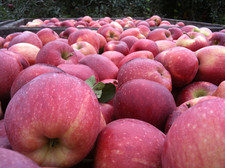 Sean emails:
Sean emails:
I've had the pleasure of visiting a handful of different apple orchards already this season and have noticed that the taste / quality of the cider has varied significantly thus far.
Now I know there's been a lot of documentation done on the region's different cider donut offerings, but I haven't seen much of anything done on the cider itself. I was wondering if some of your readers could weigh-in with where their favorite local apple cider comes from.
Bonus points if anyone has knowledge on how much the flavor changes from month-to-month or year-to-year based on what kinds of apples go into the mix.
Sean's question makes us want to go out a buy a bunch of ciders from local orchards and have a taste comparison. (Hmm...)
We've heard that the flavor of an orchard's cider can change over the course of the apple season as the different varieties of apples are harvested and added to the mix. But we can't say we've had a "Hey, wow, this cider is so much more (something) than it was last month" experience. Maybe you have.
So, got thoughts on your favorite local cider? Or any insight on how the flavor of cider changes over the course of the season? Please share!
Gathering of the Farm Cideries 2016 at Nine Pin

Nine Pin's production space.
Nine Pin Cider Works is hosting another "Gathering of the Farm Cideries" at its production space in Albany's Warehouse District on February 27. A dozen of the state's farm cideries will be there offering tastings, and products will also be for sale by the glass, growler, and bottle.
As you know, Nine Pin was the state's cidery to start operating under the state's special "farm" cidery license. The program smooths the way for small producers, and in return the cideries are required to use New York State apples for their products.
It's easy to take the apples -- and apple orchards -- for granted in Upstate New York. But we really do live in one of the premier apple-growing regions of the world -- both in terms of quantity and variety. And the recent rise of farm cideries around the state is another way to explore that.
The Gathering of the Farm Cideries is Saturday, February 27, in two sessions -- noon-3 pm and 4-7 pm. Tickets are $15 ahead and available online.
Nine Pin advertises on AOA.
Your favorite apples
 Because Friday afternoon: For the Local Harvest Festival drawing earlier this week we asked you what your favorite variety of apple. And there were 80some answers, so we tallied them up for a totally non-scientific, we-don't-even-dare-calling-it-a-survey ranking:
Because Friday afternoon: For the Local Harvest Festival drawing earlier this week we asked you what your favorite variety of apple. And there were 80some answers, so we tallied them up for a totally non-scientific, we-don't-even-dare-calling-it-a-survey ranking:
And the top 5:
1. Honeycrisp
2. Gala
3. McIntosh
4. Empire
5. Macoun
The Honeycrisp was the easy winner -- more than twice as many mentions as the Gala. We've said this before, and we'll say it again: We believe the Honeycrisp to be overrated. If you like Honeycrisp, try one one of the new Snapdragon apples.
We were heartened to see the Empire near the top. And Ashmead's Kernel even got a mention (one you should try at least once). We've gotta check out the Koru, which haven't had, yet. And there were even the obscure Fiona Apple and iMac mentioned.
The whole list, with mention counts, is after the jump.
Beyond apple pie: Four ways to use up all those apples you just picked

Sad but true: There is such a thing as too much apple pie.
New York State produces 29.5 million bushels of apples annually, with more than half of that yield sold as fresh apples (according to the New York Apple Association). With numbers like that, chances are good if you are reading this, you have recently made a trip to the orchard or are about to.
And, likely, you'll have a few errant apples left in the orchard bag or crisper drawer of the fridge. If you just can't stomach another pie or crisp or batch of applesauce, fear not: Here are four recipes to save you from the apple overload.
Talking about the history of apples
 Apple nerding: Marcia Reiss -- author of the new book Apple -- will be at the Historic Barns of Nipmoose in Rensselaer County October 18 for a "an illustrated talk about the history of the apple and its place in myth, religion, art and today's environmental challenges."
Apple nerding: Marcia Reiss -- author of the new book Apple -- will be at the Historic Barns of Nipmoose in Rensselaer County October 18 for a "an illustrated talk about the history of the apple and its place in myth, religion, art and today's environmental challenges."
Here's publisher blurbage about Apple:
Journeying back to the apple's germination in the mountains of Central Asia, Reiss travels along the Silk Road to Europe and the New World. She reveals that, from Charlemagne to Johnny Appleseed to the colonization of South Africa, where settlers were required to plant apple orchards that led to the development of new towns, apples have become a global commodity. In addition to delving into the latest debates about chemical sprays, Reiss looks at the rise of heirloom orchards and the hopes and fears of genetic developments. She also tells the parallel tale of apple cider, its decline during the Temperance Movement and its return as an artisanal alternative to wine. Beautifully illustrated with historic and contemporary images and containing a directory of popular and heirloom varieties, Apple is a book ripe for devouring.
The event at the Historic Barns of Nipmoose is Sunday, October 18 at 2 pm. It's organized by the Agricultural Stewardship Association and Battenkill Books. It will also include heirloom apples and cheese from Berle Farm, along with samples of local cider. The event is free, but the ASA asks that your RSVP at 518-692-7285.
Earlier on AOA: Beyond boring apples
Peeling apples
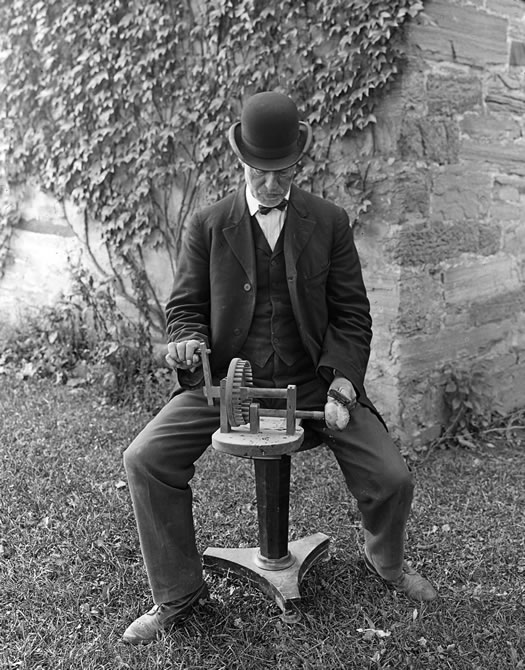
We stumbled across this image -- of a man using a device to peel an apple -- in the digital collections of the NYS Archives and it made us smile. It's like Magritte got hungry and decided it was time to eat the apple.
From the accompanying description:
New York. Schoharie. Old Fort. Man operating Apple parer apparatus. Stone structure and vine foliage in background, n.d.
We're guessing "Old Fort" is The Old Stone Fort. The image is from a collection of "lantern slides" that spanned 1856-1939. (So, maybe this is from the late 19th century.)
By the way: Here's more about those lantern slides, from the NYS Archives:
Lantern slides were compiled, mostly between 1911 and 1939, as instructional aids for the public school curriculum. More than 20,000 unique images dating from 1856-1939 document a wide variety of subjects, including New York State, North American and world geography, history, natural sciences, fine arts, trades, industries, education, and schools. The photographs were reproduced in the form of lantern slides for use in classrooms. Thousands of slides were produced by the Division of Visual Instruction and sets of slides were loaned to schools throughout the State from 1886 to 1939.
The digital collection online includes a bunch of the slides. Here's another apple-related image -- piles and piles of apples in Niagara County in 1911.
photo: NYS Archives
Genetically modified apples move closer to production
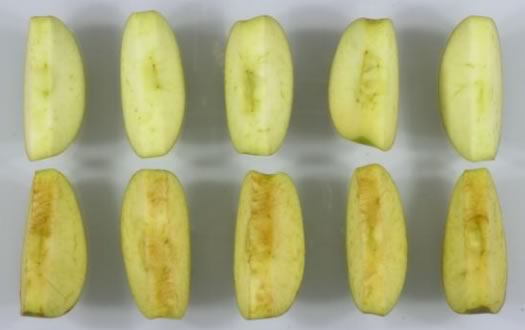
The top row are "Arctic" Granny Smith apples, and the bottom are traditional Granny Smith. / photo: Okanagan Specialty Fruits
Arctic apples -- the apples genetically modified so they don't brown when exposed to air -- have cleared one of their last regulatory hurdles, the US Department of Agriculture announced Friday. [Politico] [USDA]
Okanagan Specialty Fruit -- the company that developed the apples -- is projecting that small test-market quantities of its non-browning Golden Delicious and Granny Smith apples will available by 2016.
The technology used to create the apples is called gene silencing. Basically what Okanagan has done is target genes in the apple that are responsible for producing an enzyme involved in apples browning, and turned those genes off. The company says it's able to silence these genes very specifically. (Here's a skeptical perspective on the precision of the targeting.)
The commercial idea here is that non-browning apples will open up more opportunities for sliced apple snacks, and reduce food waste.
As you know, New York is the second largest producer of apples in the United States. Hearst reported last fall that Arctic apples were being tested at an undisclosed location upstate. Apple growers associations, both national and here in New York, have been skeptical of the genetically modified apples, not so much because of safety concerns but because of worries about how the public will perceive the apples -- essentially, apples already have a rep for being healthy and wholesome, so why do anything that could potentially mess with that. [Hearst/TU] [Modern Farmer]
Beyond boring apples
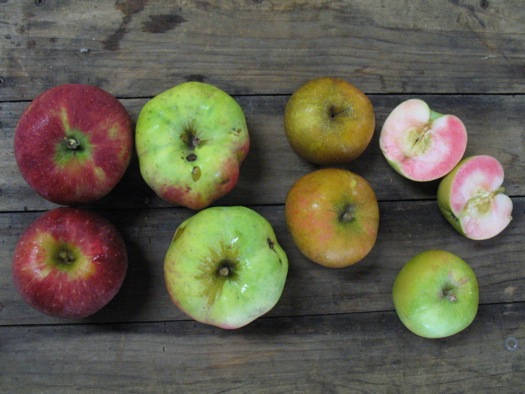
You never know what you might find inside.
One of the fun things about the Capital Region in the fall is that we're surrounded by apple orchards. And there are all sorts of good things that go along with that: weekend apple picking trips, cider donuts, all that stuff.
But it also means we have access to a wide range of different apples -- way beyond the same 10 or so varieties you see in the supermarket all the time. And given that there are literally thousands of apple varieties, why limit yourself to the same-old Macs, Galas, and (shudder) Red Delicious?
We took a drive out to Samascott Orchards in Kinderhook recently to try some unusual apples.
Tasting a Snapdragon
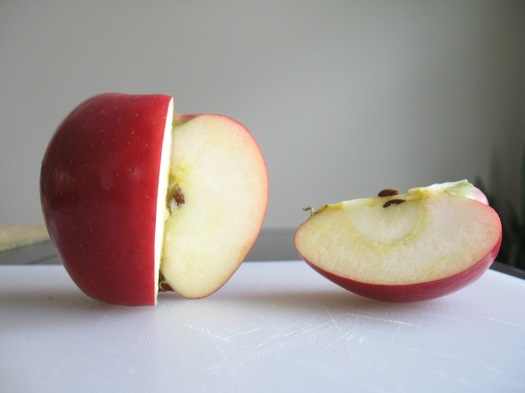
Because apples/autumn/upstate: We finally got a chance to try a Snapdragon apple, one of the new varieties publicly announced last year after being developed at Cornell. We picked a few of them up at the Samascott farm store in Kinderhook.
So, how do they taste? The texture is crunchy, and the flavor has an interesting sweetness. They've been described as having a "spicy-sweet" flavor -- and while we're not sure we'd describe it that way, it's more complex than a flat, uniform sweetness. We enjoyed the apples.
That the Snapdragon is crunchy isn't a surprise -- one of its apple parents is the super-popular Honeycrisp (the other parent is a numbered Minnesota variety). And we'd say the Snapdragon has a more interesting flavor. (Unpopular assertion: the Honeycrisp is overrated and kind of boring.)
Snapdragons are still a year away from being widely available, according to the New York Apple Association. But a handful of orchards in the greater Capital Region are growing them, including Indian Ladder, Goold, Golden Harvest, Samascott, and Bowman.
Apples as brands
The Snapdragon was introduced with the RubyFrost, and they represent a new effort by Cornell to partner with the New York Apple Growers org to license the apple varieties in North America. It fits into a wider trend within the industry to establish individual apple variety brands.
And, sure, that makes business sense. But we have to admit we're not fans of the names and slogans produced by this trend, like "CRUNCH INTO ZESTAR!"â„¢. They don't have the romance/mystery/history of names such as Esopus Spitzenburg, Worcester Pearman, or Cortland.
Earlier on AOA
+ How 'bout them (new) apples?
+ Lost and found apples
Rare spitters
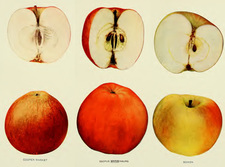 Over at Reuters there's an interesting article on a nationwide shortage of bittersweet, bittersharp, and sharp apples that have traditionally been used to make complex hard ciders. These so-called "spitter" apples are in demand because of the cider boom -- but there's a tiny supply because the apple varieties (many are heirlooms) fell out of favor over the last century or so:
Over at Reuters there's an interesting article on a nationwide shortage of bittersweet, bittersharp, and sharp apples that have traditionally been used to make complex hard ciders. These so-called "spitter" apples are in demand because of the cider boom -- but there's a tiny supply because the apple varieties (many are heirlooms) fell out of favor over the last century or so:
One reason for the apple shortage is historical. During Prohibition in the 1920s, trees known to bear hard cider apples became targets of axe-wielding FBI agents.
Popular bittersharp varieties include Kingston Black, Foxwhelp and Golden Russet. These are not dessert or eating apples such as Granny Smith.
Planting new orchards is a big commitment. An apple tree is a 25- to 30-year investment and it takes anywhere from three to six years before it becomes productive.
Greg Peck, assistant professor of horticulture at Virginia Tech University, said there are no figures for how many so-called spitters - apples too tart or bitter to eat fresh but perfect for cider making - are available currently.
In 2012, the total U.S. crop of apples was 216 million bushels, of which 1.7 million were used to make cider. Of that, Peck estimated, "only a handful" of those were bittersweet, bittersharp or sharp varieties.
While the article doesn't mention New York specifically, it indirectly points to another possible Empire State advantage for cider: orchards around here do seem to grow some unusual varieties. (We've picked Golden Russets at Samascott in Kinderhook.)
Earlier on AOA:
+ Lost and found apples
+ More fizz for the cider business in New York
Illustration from The Apples of New York State of New York Department of Agriculture (1903)
Chuck Schumer making a push for hard cider
 Chuck Schumer was at Golden Harvest in Kinderhook today pushing for legislation that would change the way the feds regulate and tax hard cider. Zzzzzzzzz... yeah, doesn't sound super exciting, but this clip from the press release explains why it could be important (emphasis added):
Chuck Schumer was at Golden Harvest in Kinderhook today pushing for legislation that would change the way the feds regulate and tax hard cider. Zzzzzzzzz... yeah, doesn't sound super exciting, but this clip from the press release explains why it could be important (emphasis added):
Schumer was joined by Golden Harvest Farms owners Alan and Derek Grout as he launched his proposal, the CIDER Act (Cider, Investment & Development through Excise Tax Reduction Act), to update the definition for hard apple and pear cider in the Internal Revenue Code (IRC) that would increase their allowed alcohol by volume from 7 percent to 8.5 percent, encompassing significantly more hard cider products and allowing them to be labeled and taxed like hard cider, rather than wine. Schumer's proposal would also address existing tax issues related to carbonation levels in hard cider, and would put the new definition in line with that of the European Union, so producers can better compete with European products abroad. Hard cider is a value-added product that is sold around the same price every year; therefore hard cider gives producers a stable source of income when apple crops suffer due to weather and other unforeseen factors. New York apple producers are increasingly interested in producing smaller, artisanal batches of hard cider, but cite the cost and difficulty to comply with the IRC definition as significant impediments to expanding their businesses.
New York is the second largest apple producer nationwide, harvesting a total of 29.5 million bushels annually from over 650 farms and 41,000 acres across the state. In recent years, thanks to the growing popularity of hard cider, many apple producers have turned to producing this craft beverage as a method to keep apple orchards profitable, generate new economic development opportunities, and attract a new visitor demographic to their farms. There have been an increasing number of hard cider producers as a result, starting with a few producers a few years ago to over 20 today. And Schumer highlighted that number should only continue to grow, as a significant number of apple farmers are interested in adding this popular product, and have sought out advice and expertise from the Cornell Cooperative to do so.
So, short story: Changing the federal rules could make it easier financially for orchards to make cider -- which could help provide new revenue to keep orchards going, and provide the rest of us with something interesting to drink.
Golden Harvest/Harvest Spirits: Schumer was at Golden Harvest because of its Harvest Spirits distillery, which already makes excellent spirits from apples (and other fruit) -- and it sounds like Harvest Spirits is also interested in getting into the hard cider business, as well.
Earlier on AOA:
+ More fizz for the cider business in New York
+ Nine Pin Cider Works in Albany
+ Eat this: Old Sin Cider from Slyboro Ciderhouse
+ Eat this: Peach Jack from Harvest Spirits
+ Poking around at Harvest Spirits
Late season apple power rankings
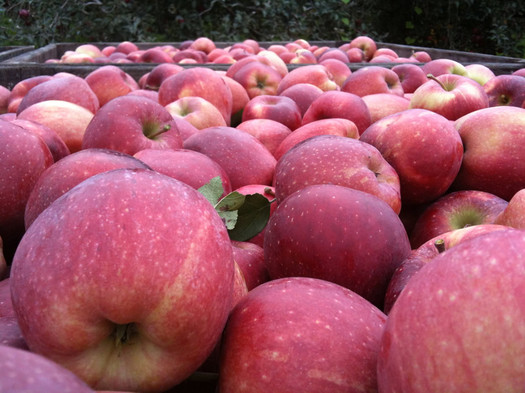
How 'bout them apples?
Now that apple season is almost over -- this upcoming weekend is probably that last for pick-your-own -- we return to our totally subjective, completely unscientific -- yet thoroughly authoritative (of course) -- power rankings of apple varieties.
See also: Early season apple power rankings.
More fizz for the cider business in New York
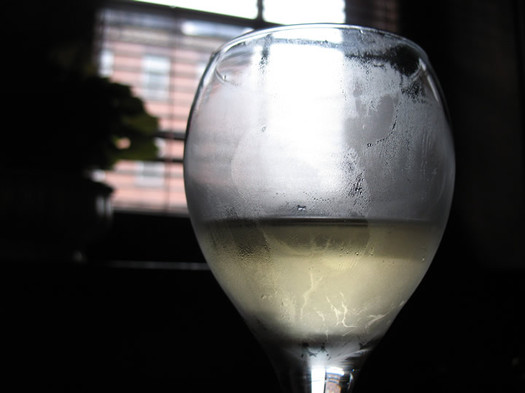
A sample of Nine Pin cider from the tasting at Smith's in Cohoes during the recent AOA Historic Bad Boys, Broads, and Bootleggers tour. Nine Pin -- a startup located in North Albany -- is aiming to have a retail product around the start of 2014.
The Cuomo admin announced Thursday that the governor has signed the Farm Cideries Bill. The legislation extends a range of opportunities and tax advantages to cideries that "farm" breweries, wineries, and distilleries in the state already had thanks to other recent legislation. From the press release:
The Farm Cideries bill authorizes the establishment and licensure of farm cideries for the manufacture and sale of cider made from crops grown in New York State and would exclude licensed farm cideries from the sales tax information return filing requirements. In order to obtain a farm cidery license, the hard cider must be made exclusively from apples grown in New York State and no more than 150,000 gallons may be produced annually. Farm cideries will be allowed to offer tastings of and sell not only cider, but also beer, wine, and spirits made from New York products. In addition, because farm cideries may also sell products such as mustards, sauces, jams, jellies, souvenirs, artwork, crafts and other gift items, these businesses, much like farm wineries, will become destination locations that will promote tourism within their communities. Also, the need for apples in the manufacture of New York State labeled cider would create a sustained demand for products from New York's farmers.
Here's a practical example of what all that means: The Farm Cider Bill opens the way for Nine Pin Cider -- the startup cider maker in North Albany -- to eventually open a tasting room and retail shop at its location on Broadway. (When we talked with Nine Pin founder Alejandro del Peral earlier this year, the Farm Cider Bill was a key part of their business plan. They had been eagerly anticipating its signing.)
For much of the last century hard cider has kind of been a fringe product compared to beer, wine, and spirits. But it has a long history in this country -- Johnny Appleseed wasn't setting up those orchards for eating apples -- and was once very popular. It never recovered its status after Prohibition, though. [Serious Eats] [Slate]
But the beverage has been on the comeback in recent years. New York State is even promoting a "cider revival." And if you look around this area, you can see signs of it taking root here (again). There's the aforementioned Nine Pin. Hicks Orchard in Granville is planting more than a thousand new trees for its Slyboro hard cider. The Rogers Family Orchard near Johnstown is setting up a hard cider operation. And apparently Saratoga Apple is considering it, too. [Nation's Restaurant News] [Post-Star] [Daily Gazette] [Saratogian]
Hey, you gotta do something with all those apples.
Earlier on AOA:
+ Nine Pin Cider Works
+ Last year the founders of the Albany Distilling Co. told us about how the state's Farm Distillery Bill helped open the way for their business
Early season apple power rankings

Can the Sansa be a contender?
5. Honeycrisp
A popular pick. And its ability to grow in colder climes is admirable. But some real talk: Honeycrisps are sweet and little else. They lack complexity. It's like they're just a bit too eager for you to like them. And have you seen the gargantuan size of some of the apples in stores lately? Too much. Let the masses eat Honeycrisps -- you can do better.
... said KGB about Drawing: What's something that brought you joy this year?